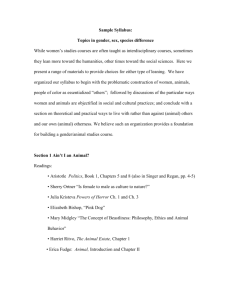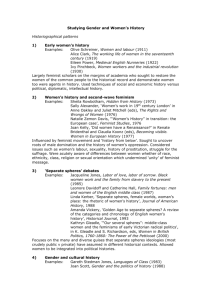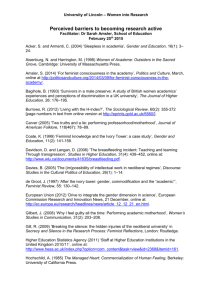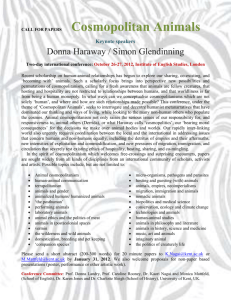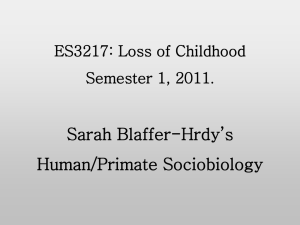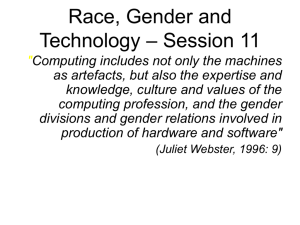HISC 217, Feminist Theory, Winter 2006
advertisement
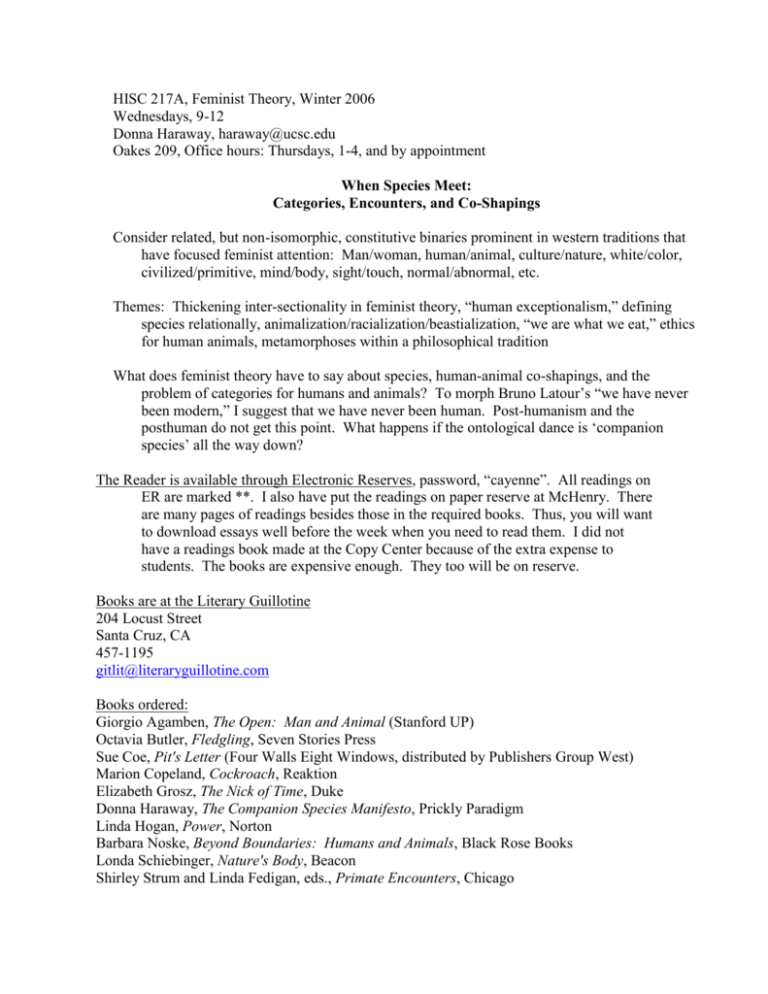
HISC 217A, Feminist Theory, Winter 2006 Wednesdays, 9-12 Donna Haraway, haraway@ucsc.edu Oakes 209, Office hours: Thursdays, 1-4, and by appointment When Species Meet: Categories, Encounters, and Co-Shapings Consider related, but non-isomorphic, constitutive binaries prominent in western traditions that have focused feminist attention: Man/woman, human/animal, culture/nature, white/color, civilized/primitive, mind/body, sight/touch, normal/abnormal, etc. Themes: Thickening inter-sectionality in feminist theory, “human exceptionalism,” defining species relationally, animalization/racialization/beastialization, “we are what we eat,” ethics for human animals, metamorphoses within a philosophical tradition What does feminist theory have to say about species, human-animal co-shapings, and the problem of categories for humans and animals? To morph Bruno Latour’s “we have never been modern,” I suggest that we have never been human. Post-humanism and the posthuman do not get this point. What happens if the ontological dance is ‘companion species’ all the way down? The Reader is available through Electronic Reserves, password, “cayenne”. All readings on ER are marked **. I also have put the readings on paper reserve at McHenry. There are many pages of readings besides those in the required books. Thus, you will want to download essays well before the week when you need to read them. I did not have a readings book made at the Copy Center because of the extra expense to students. The books are expensive enough. They too will be on reserve. Books are at the Literary Guillotine 204 Locust Street Santa Cruz, CA 457-1195 gitlit@literaryguillotine.com Books ordered: Giorgio Agamben, The Open: Man and Animal (Stanford UP) Octavia Butler, Fledgling, Seven Stories Press Sue Coe, Pit's Letter (Four Walls Eight Windows, distributed by Publishers Group West) Marion Copeland, Cockroach, Reaktion Elizabeth Grosz, The Nick of Time, Duke Donna Haraway, The Companion Species Manifesto, Prickly Paradigm Linda Hogan, Power, Norton Barbara Noske, Beyond Boundaries: Humans and Animals, Black Rose Books Londa Schiebinger, Nature's Body, Beacon Shirley Strum and Linda Fedigan, eds., Primate Encounters, Chicago 2 Course Requirements: 1) Close reading of all assignments 2) Active discussion 3) One 20-minute presentation analyzing readings and setting up the week’s discussion questions 4) Seminar paper, about 20 pp, due March 23; mid-terms prospectus with theme, questions, & preliminary bibliography due Feb 15. Please meet at least once with Donna Haraway during the term to talk about the paper. Schedule and Readings Week 1. Jan 11. Species Fictions, Part I, Vampires and their symbionts Introduction Discussion of Octavia Butler, Fledgling, Seven Stories Press (read over term break) Week 2. Jan 18. Species Fictions, Part II Student presentations on Butler, Hogan, Tiptree, LeGuin, Walker, Atwood, Anzaldua Please read: Linda Hogan, Power, Norton, 1998 [Check out: http://thewitness.org/archive/sept2002/colatostiinterview.html, http://www.ipl.org/div/natam/bin/browse.pl/A40, http://www.wwnorton.com/rgguides/powerrgg.htm] **James Tiptree, Jr, “Love is the plan, the plan is death,” in Warm Worlds and Otherwise (Ballantine, 1975), pp. 173-93 **James Tiptree, Jr., “The screwfly solution,” in Out of the Everywhere (Ballantine, 1981), pp. 53-75 **Ursula LeGuin, “’Schrödinger’s Cat’ and ‘The Author of the Acacia Seeds’” and “She unnames them,” in Buffalo Gals and Other Presences (New American Library, 1988) **From With a Fly’s Eye, Whale’s Wit, and Women’s Heart: Animals and Women (Cleis press, 1989), “Landcrab II” (Margaret Atwood) and “Interface” (Gloria Anzaldua) **Alice Walker, “Am I blue?” in Living by the Word (Harcourt Brace, 1987) Week 3. Jan 25. Beasts, Monsters, and Non-human Others: Histories & Visions Viewing of The Isle of Lost Souls, 1 hour, 11 minutes; 1930s film, banned in the UK for 35 years. H.G. Wells' adaptation of The Island of Dr. Moreau (1896). [Check out http://www.moria.co.nz/horror/isllostsouls.htm and Jonathan Burt, Animals in Film (Reaktion Books, 2002).] Visitor: H. Peter Steeves, speaker for the Cultural Studies lunch seminar (please attend if at all possible); his talk is titled “Monkey See.” Steeves’s important writing on themes 3 related to this seminar include The Things Themselves (SUNY Press, 2006 forthcoming) and his edited book in the Continental Contemporary Philosophy Series, Animal Others (SUNY Press, 1999) Please read: Londa Schiebinger, Nature's Body (Beacon,1993), esp chpts 3-5, pp. 75-183. **Lorraine Daston and Katharine Park, Wonders and the Order of Nature, chpt 5, “Monsters, a Case Study,” NY: Zone, 2001, pp. 173-214 **Harriet Ritvo, “Out of Bounds,” in The Platypus and the Mermaid and Other Figments of the Classifying Imagination (Harvard UP, 1997), pp. 131-87 [Check out: Michel Foucault, Abnormal: Lectures at the College de France, 1974-1975, Arnold I. Davidson (Introduction), 2004. Also check out (both on ER**): Eduardo Mendieta, “Philosophical Beasts” and “The Imperial Bestiary of the U.S.”] Week 4. February 1. Beastialization: Analogy, Materiality, Directionality Viewing: White Dog (1982, directed by Samuel Fuller, 84 minutes). Check out http://filmjourney.weblogger.com/2005/05/14 Please read: Marion Copeland, Cockroach (Reaktion Books, 2003) [Think back to Ovid’s and then Kafka’s Metamorphosis. The theme is ‘becoming insect’. Check out: Eileen Crist, “Can an Insect Speak?” Social Studies of Science 34, no. 1 (Feb. 2004) and Eileen Crist, Images of animals: anthropomorphism and animal mind, Philadelphia: Temple University Press, 1999.] **Arnold Arluke and Boria Sax, “The Nazi Treatment of Animals and People,” in L. Birke and R. Hubbard, eds., Reinventing Biology: Respect for Life and the Creation of Knowledge (Indiana UP, 1995), pp. 228-60 **Boria Sax, from Animals in the Third Reich: Pets, Scapegoats, and the Holocaust (Continuum, 2000), pp. 15-24, 72-91 **Angela Davis, “Rape, Racism, and the Myth of the Black Rapist,” in Women, Race and Class (Random House, 1981), pp. 172-201 **Temple Grandin and Catherine Johnson, “My Story,” in Animals in Translation: Using the Mysteries of Autism to Decode Animal Behavior (Scribner, 2005), pp. 1-67 **Carol Adams, “On Beastliness and a Politics of Solidarity,” in Neither Man nor Beast: Feminism and the Defense of Animals (Continuum, 1995), pp. 71-84 [Check out: Marjorie Spiegel, The Dreaded Comparison: Human and Animal Slavery (Mirror Books, 1997); J.M. Coetzee, Disgrace and The Lives of Animals; Kirsten Bakis, Lives of the Monster Dogs (Warner Books, 1997); Lynda Birke, Feminism, Animals, and Science (Open University Press, 1994); Carol Adams and Josephine Donovan, eds., Animals and Women: Feminist Explorations (Duke UP, 1995); Griffith, Marcie, Jennifer Wolch, and Unna 4 Lassiter, “Animal Practices and the Racialization of Filipinas in Los Angeles,” Society and Animals 10, no. 3 (2002): 222-48; Charlie LeDuff, “At a Slaughterhouse: Some Things Never Die” (in Zoontologies, pp. 182-97); Glen Elder, Jennifer Wolch, and Jody Emel, “Le Pratique Sauvage: Race, Place, and the Human-Animal Divide” (in Animal Geographies, chpt 4).] Week 5. Feb. 8. Encountering Animals I Student presentations from week’s reading Viewing: Thelma Rowell’s Non-sheepish Sheep (research DVD made by Vinciane Despret, provided by Maria Puig de la Bellacasa, visitor at Cultural Studies, UCSC, winter 2006) Please read: Shirley Strum and Linda Fedigan, eds., Primate Encounters (Chicago UP, 2000), introduction by Strum & Fedigan and then chpts by Rowell, Takasaki, Yamamoto & Alencar, Strier, Glickman, Haraway **Vinciane Despret, “The Body We Care For: Figures of Anthropo-zoo-genesis,” in Body and Society 10, no. 2 (2004): 111-34 [Check out Bruno Latour, “How to Talk about the Body? in Body and Society 10, no. 2 (2004): 205-229. Note also the indispensable journal, Society and Animals that UCSC does not have.] **Vinciane Despret, “Sheep Do Have Opinions,” in Bruno Latour and Peter Weibel, eds., Making Things Public (ZKM Center for the Arts/ MIT Press, 2005), pp. 360-68 ** Smuts, Barbara, “Encounters with Animal Minds,” Journal of Consciousness Studies 8, nos. 5-7 (2001) **Isabelle Mauz and Julien Gravelle, “Wolves in the Valley: On Making a Controversy Public,” in Bruno Latour and Peter Weibel, eds., Making Things Public (ZKM Center for the Arts/ MIT Press, 2005), pp. 370-75 Week 6. Feb. 15. Encountering Animals II Student presentations tying course materials so far together Please read: Barbara Noske, Beyond Boundaries: Humans and Animals (Black Rose Books, 1997) Sue Coe, Pit's Letter (Four Walls Eight Windows, distributed by Publishers Group West, 2000) **Cary Wolfe, “Old Orders for New: Ecology, Animal Rights, and the Poverty of Humanism,” in Animal Rites (Chicago, 2003), pp. 11-43 [Check out: Donna Haraway, “Otherworldly Conversations, Terran Topics, Local Terms” (in Haraway Reader).] Week 7. Feb. 22. Ending ‘Human Exceptionalism’: Encountering Species Student presentations 5 Please read: Donna Haraway, The Companion Species Manifesto, Prickly Paradigm Press, 2003 **Anna Tsing, “Unruly Edges: Mushrooms as Companion Species,” in ms, 2004 **Eduardo Kohn, “How Dogs Dream” and “We May Never Have Been Human, but Nonhumans Have Always Been Persons”, in ms Week 8. March 1. And say the philospher responded? Unbecoming philosopher I Student presentations Please read: Elizabeth Grosz, The Nick of Time: Politics, Evolution, and the Untimely (Duke UP, 2004), esp Introduction, Part I & II, and Conclusion **Rosi Braidotti, Chpt 3, “Transplants: Transposing Nature”, in Transpositions: On Nomadic Ethics, Polity, 2006 (in press), pdf proofs ** Jacques Derrida, “The animal that therefore I am (more to follow),” transl. David Wills, Critical Inquiry, winter 2002, v. 28, no. 2, pp. 369-417 [Check out: Jacques Derrida, “Eating Well,” in Who Comes after the Subject?, Cadava, Connor & Nancy, eds. (Routledge, 1991), pp. 96-119); Jacques Derrida, “And Say the Animal Responded?” in Zoontologies, Cary Wolfe, ed. (U. Minnesota Press, 2003); Giles Deleuze and Felix Guattari, “1730: Becoming-Intense, Becoming-Animal, BecomingImperceptible”, in A Thousand Plateaus (U. Minnesota Pr, 1987), pp. 232-309) Week 9. March 8. And say the philospher responded? Unbecoming philosopher II Student presentations Please read: Giorgio Agamben, The Open: Man and Animal (Stanford UP, 2004) **Cary Wolfe, “In the Shadow of Wittgenstein’s Lion: Language, Ethics, and the Question of the Animal, “ in Zoontologies, pp. 1-57 [Check out Jonathan Burt’s review of Zoontologies in Society and Animals 13 (2005): 167-70.] **Barbara Herrnstein-Smith, “Animal Relatives, Difficult Relations,” differences 15, no. 1 (spring 2004): pp. 1-23 Week 10. March 15. Unbecoming species? Student presentations, feast, final discussions Animal Studies Statements useful for feminist theory: a sampling “Animal Studies in the 21st Century: A New Exchange between the Sciences and the Humanities,” grant proposal to the Rockefeller Foundation, Bellagio Conference Center, Fall, 2002, Charles Bergman, Pacific Lutheran University, Project Organizer 6 Sarah Franklin and Molly Mullins, “The Animal Turn,” panels for AAA, 2000 and 2001 Eduardo Kohn, “Toward an Anthropology of Life,” research proposal for Harvard’s Society of Fellows, 2003 Adrian Franklin, human-animal studies grant proposal, Tasmania, 2005 “Political Zoology,” conference, Weimar, April 20-22, 2006 “Kindred Spirits,” Univ. of Indiana, Sept 7-9, 2006, Alyce Miller “Hudographies,” Am Assoc of Geog, Chicago, March 2006

